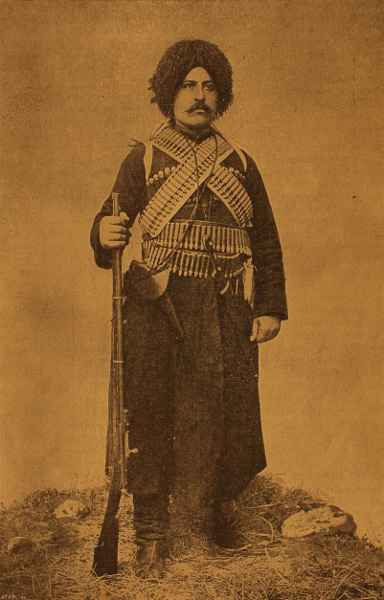Sevkaretsi Sako was born as Sargis Tzovanian in the village of Sevkar, in the Tavush province (Republic of Armenia), on January 14, 1870. Early on, he became acquainted with Sargis Kukunian, the organizer of the first expedition to Western Armenia in 1891 and cooperated with two of the founders of the Armenian Revolutionary Federation, Kristapor Mikaelian and Rostom (Stepan Zorian). He soon became a member of the party.
In 1892 Sevkaretsi Sako settled in the monastery of Derik, near the Iranian-Turkish border, to facilitate the passage of Armenian volunteers, equipment, and weapons into Western Armenia to engage in self–defense against Turkish exploitation and violence. He also participated in fights against Kurdish predators.
In July 1897 he participated as cavalry commander in the Khanasor expedition, where Armenian revolutionary fighters retaliated against the Kurdish Mazrik tribe. Afterwards, Sevkaretsi Sako settled in Vagharshapat and participated in the second congress of the ARF (1898), which elected him as member of the Central Committee of Mush–Sasun. He was sent to Western Armenia with a group accompanying him, but he was arrested by Turkish police in the plain of Mush and imprisoned in Mush and then in Erzerum. His efforts to pass as a pilgrim to the monastery of St. Karapet were futile. He was sentenced to 101 years in prison—the standard expression of life in prison in Ottoman law—and then to death, because of his activities as a fedayee, his correspondence with famous fedayees Aghpiur Serop and Kurken, and other evidence. However, the pressure exerted by the Russian consulate resulted in the extradition of Sevkaretsi Sako, who was prosecuted in a Russian court, which allowed him to be released.
Sevkaretsi Sako organized the self-defense of Kazakh-Shamshadin during the Armeno-Tatar conflict of 1905-1906. He participated in the fourth congress of the ARF (Vienna, 1907), which decided to cooperate with the constitutional revolution that had started in Persia two years before.
He returned to the Caucasus and left to his destination leading a cavalry group, but he got sick with cholera on the Russian-Persian border and was transported to Yerevan, where he passed away on November 13, 1908. He was buried in the area that currently forms the Komitas Pantheon in Yerevan. However, in 1938 the Soviet authorities destroyed his tomb, and the tombstone of white marble was moved to the tomb of Askanaz Mravian, a noted Bolshevik activist.
A bust of Sevkaretsi Sako remembers him in his birthplace Sevkar and a street is named after him in the Nor Arabkir neighborhood in Yerevan.

